
Uncovering the Wonders of Dougga: A City that Embodies the Spirit of the Roman Empire in Africa
The ancient city of Dougga, found in present-day Tunisia, stands as a testament to the rich cultural heritage of the Roman Empire in Africa. With its numerous temples, theaters, and triumphal arches, Dougga was a bustling hub of activity during its heyday. Today, its well-preserved ruins offer a fascinating glimpse into the past, revealing the ingenuity, creativity, and sheer ambition of its builders. Step back in time and discover the wonders of Dougga, a city that truly embodies the spirit of the Roman Empire in Africa.
The Ancient History of Dougga: Early History
Dougga (also spelled Thugga) has a long, storied history but is best known from the time of its Roman conquest. Our knowledge of the city before the conquest is a little fragmented, with sources being unreliable.
It’s widely believed the city was founded in the 6th century BC and it has been suggested that it was the city of Tocae that was captured by the Greek tyrant, Agathocles, at the end of the 4th century BC. Tocae was described by Diodorus of Sicily (a Greek historian) as a “city of beautiful grandeur”, giving us an idea of what Dougga was like before the Romans arrived.
Even if Dougga wasn’t actually Tocae, archaeological evidence points to it being an impressive, vibrant city well before the Roman conquest. Archaeologists have found a necropolis with dolmens (a type of megalithic tomb), a sanctuary dedicated to Ba’al Hammon (an early pagan god), neolithic steles (decorated wood/stone slabs), a mausoleum and a temple dedicated to Masinissa (a major Ancient North African king) that all date back to before the Roman Conquest.
We know that it became an important Numidian town during the reign of Masinissa who ruled from 238-148 BC. During this time, it was an ally of Carthage, which was a growing empire to the northeast. The close ties between the two powers can be seen at Masinissa’s mausoleum which hosts inscriptions in both Numidian and Punic (the language of Carthage).
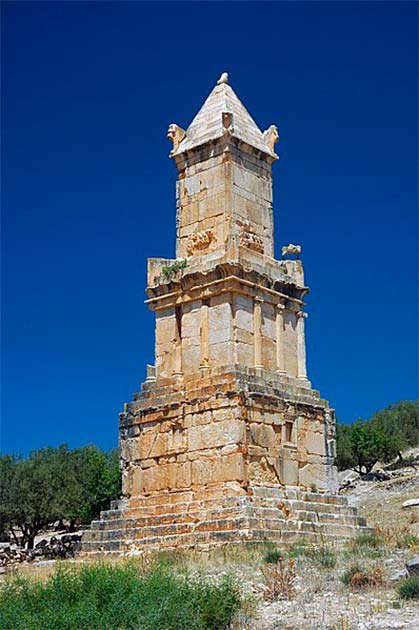
Mausoleum, Dougga in Tunisia. (GIRAUD Patrick/CC BY 3.0)
The town was located right at the edge of both empires’ spheres of influence, leading to it being incredibly prosperous. Tombs found in Dougga were full of jewelry, glass vessels, and pottery from as far away as Greece and Italy.
But things wouldn’t stay peaceful between Dougga and Carthage forever. Dougga was invaded by Carthage during the 3rd century BC as the Carthaginians sought to expand their power and reach. The invasion occurred during the Second Punic War, a conflict between Rome and Carthage, that raged on between 218 BC and 201 BC.
- Nabta Playa and the Ancient Astronomers of the Nubian Desert
- The History and Photogenic Ruins of the Forgotten City of Thuburbo Maius
Rome eventually sent a force led by general Scipio Africanus to North Africa in an attempt to curb Carthaginian influence. Africanus was ultimately successful in his mission and defeated the Carthaginians and their Numidian allies in a series of brutal battles, including the Battle of Zama in 202 BC.
After their defeat, the Carthaginians gave up their territories in North Africa to Rome. This included Dougga. Things were about to change.
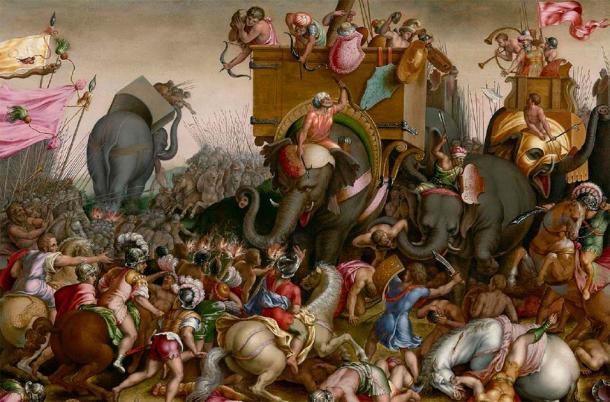
The Battle of Zama. ( Art Institute of Chicago / Public domain)
Dougga Under Rome
After the Roman conquest of the region, Dougga was granted the status of an indigenous city. This meant it was recognized as a pre-existing city and allowed a certain degree of autonomy. However, the creation of the colony of Carthage shortly afterwards complicated its institutional status as the city was included in the territory of the colony. This led to some disagreements over who was actually in charge.
A community of Roman colonists arose alongside the existing settlement, resulting in the site being governed by two civic and institutional bodies for two centuries. The city had its own magistrates and council, while the Roman populace had their own administrators who were legally subordinated to the colony of Carthage. The town was also governed by Punic judicial administrators called sufetes. It was all rather complicated.
Over time things became simpler as the two communities grew closer. The magistrates of the city automatically received Roman citizenship during the reign of Marcus Aurelius, and the rights of the city's inhabitants became like those of Roman citizens.
The city won a certain degree of autonomy from Carthage and was able to decide how it spent public money. This status quo remained until the reign of Septimius Severus, and in AD 205 the two communities came together as one municipality and Dougga became a municipium. This meant that Dougga and its people were officially Roman citizens and could self-govern.
The city was supported by wealthy families and successfully appealed to the emperors to represent its interests. Dougga's development culminated during the reign of Gallienus (253-268 AD) when it obtained the status of a separate Roman colony. However, the city's prosperity declined from the 4th century AD, as evidenced by the relatively poor remains of Christianity.
- The Amphitheatre of El Djem: Gladiatorial Arena of Tunisia
- The Rich Mythology and Megalithic Culture of the Ancient Berbers, Lords of the Desert
After the Romans
Of course, eventually, the Roman Empire fell. Dougga survived this too. After the fall of the West Roman Empire in the 5th century, Dougga was taken over by the Vandals, a Germanic people who had had expanded their kingdom to North Africa.
Dougga’s time under the Vandals was short-lived. By the 6th century AD, the Byzantine Empire had reconquered North Africa and Dougga along with it. Under Byzantine rule, the city was transformed into a Byzantine fortress. Sadly, some of its ancient buildings were destroyed to supply building materials for the construction of the fortifications during this time.
Later, in the 7th century, the Arab Muslim conquest of north Africa began. Dougga came under Arab rule but the city was gradually abandoned and its ruins were left untouched for centuries.
A small number of people continued to live in Dougga until the modern day, but the city was a shadow of its former self. It wasn’t until the 19th century when European archaeologists started work that the world remembered what a hidden gem Dougga really was.
Archaeological Work
While archaeological work began during the 19th century, the site was first rediscovered by western visitors in the 17th century. Their eyewitness accounts led to more western visitors arriving in Dougga throughout the 18th and 19th centuries.
Things really got underway when, in 1881, France established the Tunisian protectorate which in turn led to the founding of a national antiquities institute. Work began in earnest in 1901 and the first digs concentrated on the area around the town’s forum. Soon, important archaeological discoveries piled up and a constant series of digs was carried on until 1939.
Alongside these digs, restoration efforts were being made. In particular, major restoration works were carried out at the capitol, (only the front and base of the wall were still standing in 1901) and the impressive mausoleum.
After Tunisia gained independence in 1956, the excavations at Dougga restarted and important new finds such as the Temple of Caracalla's Victory were excavated. Up until this point people had actually still been living at Dougga but they were ultimately evicted during this period. They were relocated to a nearby village that was renamed New Dougga.
In 1991 the Tunisian government declared the site a national archaeological park. It was then added to the UNESCO World Heritage sites list in 1997.
Despite its historical importance, Dougga is currently being held back by its location. Sites like Dougga often rely on the money that comes from tourism to continue archaeological/ restoration work.
Sadly, Dougga remains off the beaten track and difficult for tourists to reach. It only receives about 50,000 visitors a year. It’s simply too far for most tourists to bother visiting. It is hoped that the construction of an on-site museum will lure in more visitors and their wallets.
Layout of Dougga
For those lucky enough to visit the ancient city, they’ll find that it mainly consists of ruins dating back to the Roman era of the 2nd and 3rd centuries AD. These ruins are interesting because they do not resemble the typical layout of Roman settlements from the period. The city has a rather unusual layout as the Roman builders had to work around the area’s craggy terrain and pre-existing buildings.
Recent archaeological excavations have demonstrated that the urban development of the city was continuous, with the city's core always being located on top of the hill, where the forum was built in place of the Numidian agora.
The city expanded on the side of the hill, creating a dense urban center. Initial archaeological explorations mainly focused on public buildings but private buildings were found towards the end of the trenches. Later, specific trenches were dug to uncover more of the private buildings and their characteristics.
The sheer number of structures that are at the site is impressive. Ranging from residential to religious, political and recreational, historians have gained a wealth of knowledge from their excavations at Dougga. Below are some of the highlights.
The Archaeological Gems at Dougga: Numidian Residences
While most ruins found at Dougga date back to Roman times; a few survive that pre-date the Romans by a several centuries. In the foundation of the Liber temple, faint remains of a Numidian residence have been found.
The most interesting thing about these residences is they tell us how the city grew. Early historians believed that the Roman and pre-Roman settlements were separate and situated at different sites. The Numidian residences, however, show that the two were one and the same.
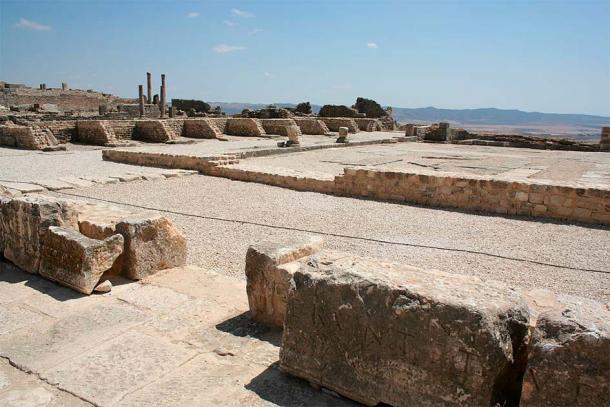
The remains of the market in Dougga. (Pradigue/CC BY-SA 3.0)
The Market
The market, built in the mid-1st century, had a square shape measuring 35.5 m × 28 m (116 ft × 92 ft) and was surrounded by a colonnade and had shops on two sides. The northern side had a portico with an exedra (a kind of meeting place) situated on its southern side, which was likely used to house a statue of Mercury.
Due to the city’s uneven terrain, the Roman builders had to undertake extensive earthworks to build the market. It is believed that it is one of the earliest Roman structures at Dougga and that it was most likely not built on pre-existing foundations.
Sadly, today little remains of the original Roman market. It was largely destroyed during the construction of the Byzantine fort; what remains today was excavated between 1918 and 1919.
The Triumphal Arches
Two triumphal arches can still be found in Dougga. One of them is the heavily damaged arch of Septimius Severus, built in 205 AD. This arch is situated near the mausoleum on the route between Carthage and Théveste.
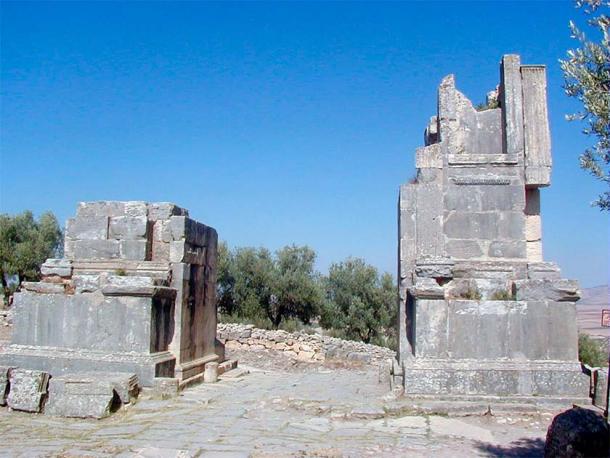
The remains of the Septimius Severus Arch in Tunisia. (Pradigue/CC BY-SA 3.0)
The other one is Alexander Severus's arch, which was constructed between AD 222-235. This later arch is relatively well preserved, although much of its upper parts are missing. This arch is equidistant from the capitol and the Temple of Juno Caelestis and its arcade measures 4 meters (13 ft) in height. Sadly, a third triumphal arch from the Tetrarchy period has been completely lost.
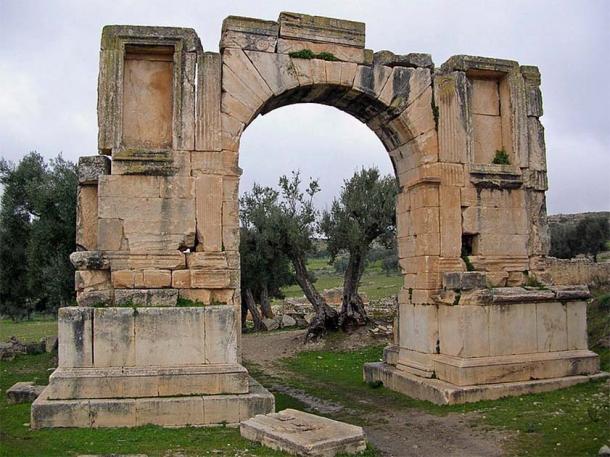
Arch of Alexander Severus, Dougga, Tunisia (Bernard Gagnon/CC BY-SA 3.0)
The Forum and Capitol
The small city forum measures 924 square meters (9,950 sq ft). Much like the market, it has varying degrees of preservation thanks to damage done by the Byzantines during the construction of their fort.
The capitol, located in an area surrounded by porticos, dominates the surrounding landscape with its impressive appearance. It features a square called "square of the Rose of the Winds" which in reality is more like a walkway that connects it to the Temple of Mercury to the North. The curia and a tribune (meeting places for local politicians) for speeches likely also stood here.
It is in the substructures behind the capitol that the mausoleum dedicated to Masinissa was first found. It was this discovery that first told archaeologists that a major conurbation had been at Dougga before the Roman conquest.
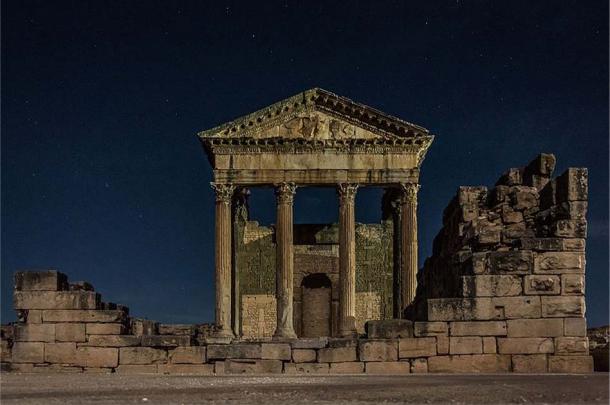
The capitol of Dougga is a Roman temple from the 2nd century, principally dedicated to Rome’s protective triad: Jupiter Optimus Maximus, Juno Regina and Minerva Augusta. The Capitol is the most preserved in Tunisia. (IssamBarhoumi/CC BY-SA 4.0)
Theater
The theater in Dougga, constructed around 168 or 169 AD, is an exceptional example of Roman architecture in Africa and is still well-preserved. Despite Dougga's population that is only around 5,000 inhabitants, the theater could accommodate up to 3,500 spectators.
As with many of the buildings at Dougga, the theater deviates from the “typical design” of a Roman theater thanks to the city’s terrain. The theater was built by P. Marcius Quadratus, as indicated by the dedication engraved into the pediment of the stage and on the portico overlooking the city. The theater is still used for classic theater performances, especially during the Dougga festival, and has undergone restoration work.
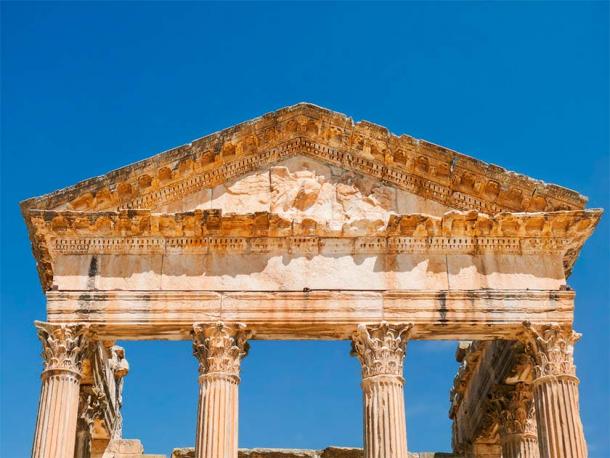
Architectural detail of the portico of the ancient theater at Dougga. (Konstantin Aksenov/Adobe Stock)
Circus
Dougga is also the proud home of an impressive Roman circus. What was once just a field, donated by a local called Gabinii in 214 AD, became one of the most magnificent Roman circuses in Africa.
The demand for a large circus was such that magistrates only gave builders a year to complete construction. When finished, it measured 393m (1,289 ft) long with a spina (barrier) of 190m × 6m (623ft × 20ft), making it the grandest circus in Africa.
The circus marks Dougga as one of the most important cities in the province. Sadly, little remains of it today (it was basically just a big field even in its heyday) but it is a reminder of the importance of spectacles in the social life of Roman cities and the demand for popular entertainment.
Temples
Dougga is a small city with a surprisingly large number of temples, as confirmed by both archaeological and epigraphic evidence. Over twenty temples have been identified, with eleven of them supported by archaeological remains and inscriptions, another eight only by archaeological remains, and another fourteen referred to by inscriptions. This abundance of religious sites is due to the generosity of wealthy families.
Conclusion
As we conclude our exploration of Dougga, we are left with a vivid picture of a thriving city in the heart of Roman Africa, replete with impressive monuments, stunning architecture, and a rich cultural heritage. From the meticulously preserved theater to the sprawling temple complex, Dougga's legacy stands as a testament to the ingenuity and creativity of the ancient Roman civilization.
Top image: Ancient city of Dougga. Unesco World Heritage Site in Tunisia. Source: Konstantin Aksenov/Adobe Stock
References
Bagnall. R. 2012. The Encyclopedia of Ancient History. Wiley-Blackwell.
Cartwright. M. 2016. Thugga. Available at: https://www.worldhistory.org/Dougga/
Stamper. P. 2021. Dougga. Available at: https://www.historyhit.com/locations/dougga/















